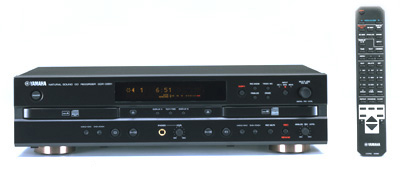CD Formats
In the previous sections, we looked at the basic idea of CD and CD-burner technology. Using precise lasers or metal molds, you can mark a pattern of more-reflective areas and less-reflective areas that represent a sequence of 1s and 0s. The system is so basic that you can encode just about any sort of digital information. There is no inherent limitation on what kind of mark pattern you put down on the disc.
But in order to make the information accessible to another CD drive (or player), it has to be encoded in an understandable form. The established form for music CDs, called ISO 9660 , was the foundation for later CD formats. This format was specifically designed to minimize the effect of data errors .
 Photo courtesy Yamaha Electronics Corporation The Yamaha CDR-D651, a dual-tray stereo-component burner: With this burner, you take music tracks directly off of another CD, instead of from your hard drive. Burners like this are usually fast and accurate, but typically can only be used to create music CDs. |
This is accomplished by carefully arranging the recorded data and mixing it with a lot of extra digital information. There are a number of important aspects involved in this system:
Trailer Track
CD-Rs and CD-RWs have a component that ordinary music CDs do not have -- an extra bit of track at the beginning of the CD, before time zero (00:00), which is the starting point recognized by CD players. This additional track space includes the power memory area (PMA) and the power calibration area (PCA). The PMA stores a temporary table of contents for the individual packets on a disc that has been only partially recorded. When you complete the disc, the burner uses this information to create the final table of contents. |
- The CD track is marked with a sort of timecode , which tells the CD player what part of the disc it is reading at any particular time. Discs are also encoded with a table of contents , located at the beginning of the track (the center of the disc), which tells the player where particular songs (or files) are written onto the disc.
- The data track is broken up by extra filler , so there are no long strings of 1s or 0s. Without frequent shifts from 1 to 0, there would be large sections without a changing pattern of reflectivity. This could cause the read laser to "lose its place" on the disc. The filler data breaks up these large sections.
- Extra data bits are included to help the player recognize and fix a mistake . If the read laser misreads a single bit, the player is able to correct the problem using the additional encoded data.
- Recorded information is not encoded sequentially; it is interlaced in a set pattern. This reduces the risk of losing whole sections of data. If a scratch or piece of debris makes a part of the track unreadable, it will damage separate bits of data from different parts of the song or file, instead of eliminating an entire segment of information. Since only small pieces of each file segment are unreadable, it's easier for the CD player to correct the problem or recover from it.
The actual arrangement of information on music CDs is incredibly complex. And CD-ROMS -- compact discs that contain computer files rather than song tracks -- have even more extensive error-correction systems. This is because an error in a computer file could corrupt an entire program, while a small uncorrected error on a music CD only means a bit of fuzz or a skipping noise. If you are interested in the various ways that data is arranged on different types of CDs, check out Audio Compact Disc - Writing and Reading the Data .
With some writable CD formats, you have to prepare all of the information before you begin burning. This limitation is built into the original format of CDs as well as the physical design of the disc itself. After all, the long track forms one continuous, connected string of 1s and 0s, and it's difficult to break this up into separate sections. With newer disc formats, you can record files one " packet " at a time, adding the table of contents and other unifying structures once you've filled up the disc.
CD burners are an amazing piece of technology, and the inner workings are certainly fascinating. But to the typical computer user, the most compelling aspect of burners is what you can do with them. In the next section, we'll find out how you can put all of this technology to work and make your own music mix.
Back to How It Works
› Introduction to How CD Burners Work
› CD Basics
› Reading & Writing CDs
› Burning CDs
› Erasing CDs
› CD Formats
› Creating Your Own CDs